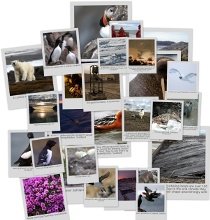Through the North

After London, I flew back to Finland, where I had two relaxed days at my parent's. There was just enough time to unpack shorts, hammocks and mosquito nets and stuff up my backpack with warm winter clothes, before I had to take off again. A new field season was about to start. It was time to head back to the North.
Because flying is such a superficial way of traveling, it's more fun to take the train & bus combination through Finland to Tromsø in the Northern Norway. During the trip one sees how variable landscape the country has. Mighty conifer forests chance to fields and small houses of East Bothnia. The sun is set, but there is lots of light, although it's close to mid-night. When getting closer to Rovaniemi the fields have changed back to conifer forests, which are somewhat shorter, and the trees thinner, than in the South. The train reaches Rovaniemi by morning. It's raining and much colder than in Tampere. I have to change to a bus, which takes me through the most beautiful county in Finland. Lapland is huge, swampy and forested. Big lakes are replaced by rivers. The forest is getting scrubbier and the vast swamps even vaster when travelling northwards.
After Muonio the conifer forest changes to aggregations of scrubby birch bushes, river plains and swamps. In Kilpisjärvi there are fjells covered by tundra and snow, the lake (kilpi means shield or shelter and järvi lake in Finnish) and some smaller rivers. Very scrubby birch bushes are covering valleys. The birches haven't got leaf yet. Newly fallen snow is covering the back of Saana, the characteristic and famous fjell lying on the shore of lake Kilpisjärvi.
I arrive to the shop, Kilpishalli, which is the end point of public transport in Finland. Apart from three summer months, there is no public link between Finland and Norway. One has to use private car. From now on, I am on my own.
I start asking for a lift to Norway from the Norwegians who have came after cheaper beer and meat. I use my poor Norwegian, partly to show respect, partly because many of the older people are not speaking English. After an hour or so, I start to get desperate. Hitch-hiking is not part of Norwegian culture. They probably think that everyone should have their own car.
The shop is closing. Just at the last moment I get lucky. Pair of older Norwegians kindly promise to take me to Norway to the place, where I can take a bus to Tromsø. They're about 70 years old mother and her daughter. Obligated I try to keep up conversation, while we're passing high, snow covered mountains. Creeks are flowing down to valleys on steep slopes. Leaves in birches are getting bigger, greener and more mature as we drive down towards the sea. River Skibotnelva flows majestically in it's valley. I can't help smiling. It all looks a bit like Svalbard. It feels so homely, like the place I belong.
Tromsø is as grey, rainy and foggy as any town on the Norwegian coast during the summer. Last time I was here, it was dark excluding few blue hours during the mid-day. Now it's light all the time. One can't notice difference between the day and night. It's cloudy, cold and raining constantly, but the weather doesn't matter. The friends here make the place warmer than any other in the tropics could be.
On Monday, I am going to fly to Svalbard, where I am working on the field for the whole summer, which means about three months that north. I'll be a field assistant for the sea bird research at Norwegian Polar Institute. This basicly means, that I am going to drive around with a speed boat after auks, guillemots, gulls and puffins. I'll be doing various tasks from banding, to food and blood sampling and to counting sea birds at the sea and on colonies. It's about as close to my dream job, as anything.



























 It would be possible to spend weeks in KL doing and seeing new things every day, but it's time to move on. Departure at 4 am tonight. Borneo, diving, birds, orang-utans, jungles and Mount Kinabalu, here we come!
It would be possible to spend weeks in KL doing and seeing new things every day, but it's time to move on. Departure at 4 am tonight. Borneo, diving, birds, orang-utans, jungles and Mount Kinabalu, here we come! 






























